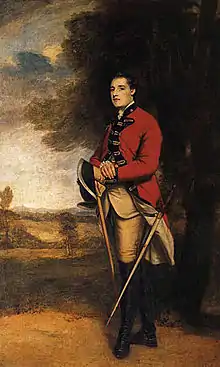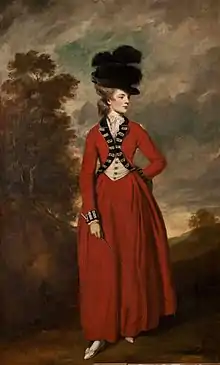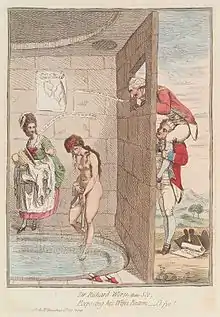Sir Richard Worsley, 7th Baronet
Sir Richard Worsley, 7th Baronet, PC, FRS, FSA (13 February 1751 – 8 August 1805) was a British politician who sat in the House of Commons between 1774 and 1801. He was a noted collector of antiquities.
Sir Richard Worsley | |
|---|---|
 by Joshua Reynolds (1775/6) | |
| Comptroller of the Household | |
| In office 1779–1782 | |
| Preceded by | The Earl of Onslow |
| Succeeded by | The Earl Ludlow |
| Personal details | |
| Born | 13 February 1751 |
| Died | 8 August 1805 (aged 54) |
| Spouse(s) | Seymour Dorothy Fleming |
Early life
Worsley was born on 13 February 1751, at Appuldurcombe House, near Wroxall on the Isle of Wight, the son of Sir Thomas Worsley, 6th Baronet (1726–1768) and Elizabeth Boyle (1731–1800), daughter of John Boyle, 5th Earl of Cork and Henrietta, his first wife. He succeeded to his father's baronetcy on 23 September 1768.[1]

Educated at Winchester College, Worsley spent about two years in Naples with his parents from 1765 to 1767, before matriculating at Corpus Christi College, Oxford on 9 April 1768.[2] Instead of taking a degree, he decided to complete his education with a continental Grand Tour from 1769 to 1770, being tutored by Georges Deyverdun, who was a contact of Edward Gibbon, a family friend.[1][3]
Political career
After his return to Britain Worsley served as High Sheriff of Hampshire for 1773-74 and then entered the House of Commons in 1774 for the constituency of Newport. A supporter of the Lord North government, he was appointed a clerk comptroller of the board of green cloth in 1777, comptroller of the king's household (1779–82), privy councillor (from 1780) and Governor of the Isle of Wight (1780–82). In 1775 he married.[4][1]
1779–1788
Worsley failed to win a seat at the Hampshire by-election of December 1779 and lost all his offices when the North administration fell in 1782. Scandals involving his wife further damaged his political career. Worsley left for Spain, Portugal, and France (1783–84, quitting his parliamentary seat after his departure) and wintered in Rome. After further travels, he returned to England in 1788.
1790–1805

Worsley re-entered Parliament as MP for Newtown, Isle of Wight, from 1790 to 1793. He became British ambassador to the Republic of Venice from 1794 until Venice's annexation by France in 1797. In the latter post he continued collecting antiquities (the French Revolutionary Wars keeping prices low at the time) and worked hard to keep France's ambassador from taking advantage of Venice's neutrality. He managed to escape Venice when the French invaded, transferring soon after his departure from a civilian convoy to a 14-gun Royal Navy sloop, leaving his art collections from Venice on the convoy with instructions to stay at Fiume to await a more peaceful situation in which to continue to England. He landed in England in mid-September 1797 and received a £600 annuity from the crown for his services.
Having been re-elected in absentia for Newtown in 1796, Worsley held that seat until Pitt the Younger resigned in February 1801, ending his participation in public life.
Antiquarian and collector
In 1778 Worsley was elected a Fellow of both the Society of Antiquaries of London and the Royal Society.[5]
In February 1785 he left Rome for the Levant with Willey Reveley as draughtsman. He visited Athens (from 1785), the Greek interior, Rhodes, Cairo, Constantinople, Sigeion (1786), Troy (1786) and the Crimea. During his travels he built up a collection of gems, paintings, sculpture and reliefs. He lost the paintings when the collection was interned in Portugal during his return from the east to Britain via Rome in 1787–88. In Rome he bought more antiquities from Thomas Jenkins and Giovanni Battista Piranesi, and became a friend of the Spanish ambassador, Jose Nicolas de Azara, and the antiquary Ennio Quirino Visconti (who would later write the text for Worsley's publication of his collections (1794–1805)).
On his return Worsley arranged the collection at his house at Appuldurcombe, where he had the grounds landscaped by Capability Brown. His was the most extensive collection of ancient Greek sculpture in Britain, before the arrival of Elgin Marbles.
Worsley went into seclusion, principally at Sea Cottage (later known as Marine Villa), which he built in the early 1790s near St Lawrence, in the Undercliff of the Isle of Wight, adding small classical temples in its grounds and making a failed attempt to add a vineyard. In 1801 he received news from a British government agent that a French privateer had brought the ship carrying his art treasures into Málaga and that the paintings onboard had been bought up cheaply by Lucien Bonaparte. Only the antiquities remained, which he reacquired by paying the French bounty on them.
Last years and death

Poor health prevented Worsley from taking part in defending the Isle of Wight against the Napoleonic invasion threat, but he carried on collecting until his death. He died of apoplexy on 8 August 1805 at Appuldurcombe House and was buried at the parish church at Godshill. Most of Worsley's collections went to Brocklesby Park.
Works
- Completion of a History of the Isle of Wight by his father and grandfather, 1781
- Museum Worsleianum, or, A collection of antique basso relievos, bustos, statues and gems, with views of places in the Levant taken on the spot in the year MDCCLXXXV, VI and VII. (2 vols., London: From the Shakespeare Press by W. Bulmer & Co., 1794) [This catalogue of his collection has the date 1794 on both title-pages, but was issued serially in six fascicles] – part one issued 1798 (costing £2,887 4s), part one issued 1802. This work was written jointly with Ennio Quirino Visconti.[6]
- Catalogue Raisonné of the Principal Paintings at Appuldurcombe (1804, privately printed)
Family
On 20 September 1775 Worsley married Seymour Dorothy Fleming, the younger daughter and coheir of Sir John Fleming, 1st Baronet, of Brompton Park, Middlesex, and his wife, Lady Jane Fleming (died 1811). They had one legitimate son, Robert Edwin (1776–1795) and he claimed the paternity of Seymour's daughter, Jane Seymour Worsley, even though he knew her to be the daughter of Seymour's lover, George Bisset. This was done to avoid scandal, allowing the affair to remain a secret. Seymour Fleming brought £52,000 to the marriage, which soon became unhappy.

His wife was rumoured to have 27 lovers, and in 1782 Worsley brought a criminal conversation case for £20,000 against one of them, George M Bissett, a Hampshire militia officer who lived near to them. The jury decided that Worsley had connived in the adultery and awarded him only one shilling in damages. In 1788 he and his estranged wife entered into articles of separation. After the separation, she reverted to her birth name, Fleming. Worsley began an affair with a Mrs Sarah Smith, which lasted until his death.
The baronetcy passed to Worsley's fourth cousin, Henry Worsley-Holmes. Fleming's £70,000 jointure reverted to her, and just over a month later, on 12 September, she married John Lewis Cuchet at Farnham.
Worsley left the estate saddled with heavy debts. Appuldurcombe passed to his niece, Henrietta Anna Maria Charlotte (daughter of John Bridgeman Simpson), who married the Hon. Charles Anderson-Pelham, later first earl of Yarborough, in 1806.
References
- "WORSLEY, Sir Richard, 7th Bt. (1751-1805), of Appuldercombe, I.o.W." History of Parliament. Retrieved 24 June 2017.
- Foster, Joseph (1888–1892). . Alumni Oxonienses: the Members of the University of Oxford, 1715–1886. Oxford: Parker and Co – via Wikisource.
- Aston, Nigel. "Worsley, Sir Richard". Oxford Dictionary of National Biography (online ed.). Oxford University Press. doi:10.1093/ref:odnb/29986. (Subscription or UK public library membership required.)
- "No. 11375". The London Gazette. 6 February 1773. p. 1.
- "Fellow details". Royal Society. Retrieved 24 May 2016.
- Rubenhold, Hallie (2011). Lady Worsley's Whim: An Eighteenth-Century Tale of Sex, Scandal and Divorce. Random House. p. 235. ISBN 9781446449691.
Further reading
- Aston, Nigel (2009) [2004]. "Worsley, Sir Richard, seventh baronet (1751–1805)". Oxford Dictionary of National Biography (online ed.). Oxford University Press. doi:10.1093/ref:odnb/29986. (Subscription or UK public library membership required.)
- Bignamini, Ilaria; Hornsby, Clare (2010). Digging and Dealing in Eighteenth-Century Rome. 1. New Haven: Yale University Press. pp. 343–346. ISBN 9780300160437.
- Robbins, Michael (1978). "Sir Richard Worsley". In Simmons, Jack (ed.). English County Historians: first series. Wakefield: EP Publishing. pp. 222–240. ISBN 0-7158-1309-9.
- Rubenhold, Hallie (2008). Lady Worsley's Whim: An Eighteenth-Century Tale of Sex, Scandal and Divorce. London: Chatto & Windus. ISBN 978-0701179809. [US title: The Lady in Red]
- Attribution
![]() This article incorporates text from a publication now in the public domain: Wroth, Warwick William (1900). "Worsley, Richard". In Lee, Sidney (ed.). Dictionary of National Biography. 63. London: Smith, Elder & Co.
This article incorporates text from a publication now in the public domain: Wroth, Warwick William (1900). "Worsley, Richard". In Lee, Sidney (ed.). Dictionary of National Biography. 63. London: Smith, Elder & Co.
| Parliament of Great Britain | ||
|---|---|---|
| Preceded by Hon John St John Hans Sloane |
Member of Parliament for Newport 1774–1784 With: Hans Sloane 1774–1780 Hon John St John 1780–1784 |
Succeeded by Edward Rushworth Hon. Hugh Seymour-Conway |
| Preceded by George Canning John Barrington |
Member of Parliament for Newtown 1796–1801 With: Charles Shaw Lefevre |
Succeeded by Parliament of the United Kingdom |
| Parliament of the United Kingdom | ||
| Preceded by Parliament of Great Britain |
Member of Parliament for Newtown 1801 With: Charles Shaw Lefevre |
Succeeded by Sir Edward Law Charles Shaw Lefevre |
| Political offices | ||
| Preceded by The Earl of Onslow |
Comptroller of the Household 1779–1782 |
Succeeded by The Earl Ludlow |
| Diplomatic posts | ||
| Preceded by Francis Drake |
British Minister Resident to the Republic of Venice 1793–1797 |
Succeeded by Abolished |
| Honorary titles | ||
| Preceded by Hans Stanley |
Governor of the Isle of Wight 1780–1782 |
Succeeded by The Duke of Bolton |
| Vice-Admiral of the Isle of Wight 1780–1791 |
Succeeded by Thomas Orde | |
| Baronetage of England | ||
| Preceded by Thomas Worsley |
Baronet (of Appuldurcombe) 1768–1805 |
Succeeded by Henry Worsley-Holmes |